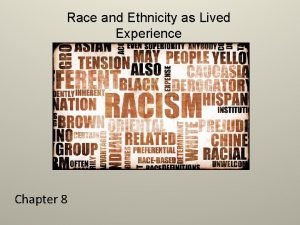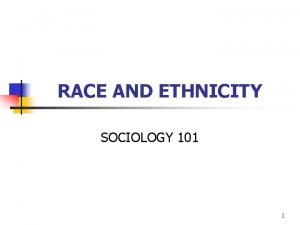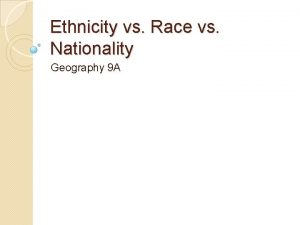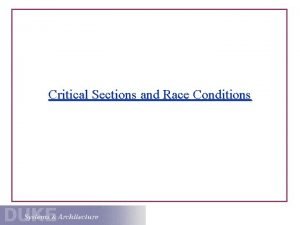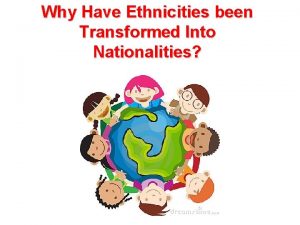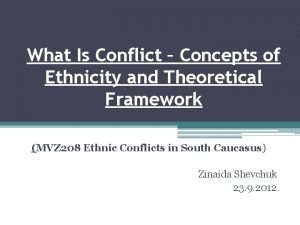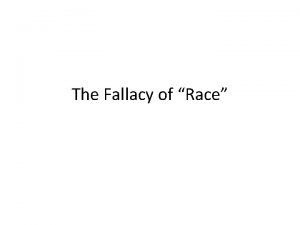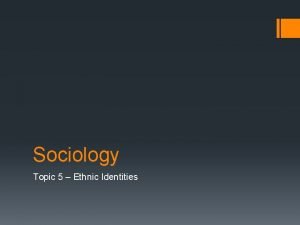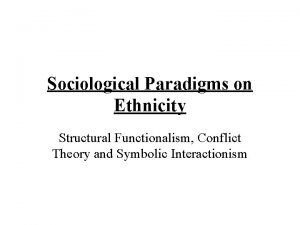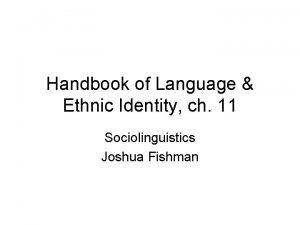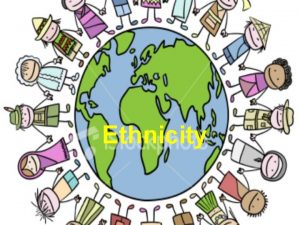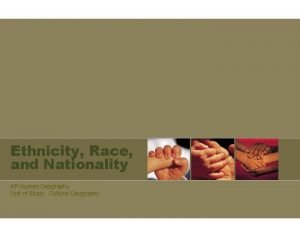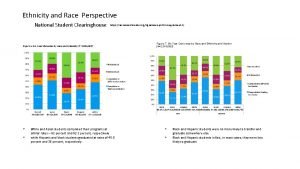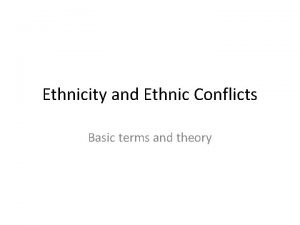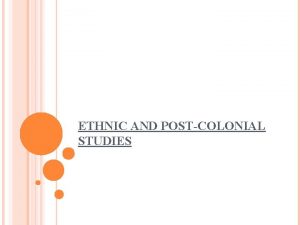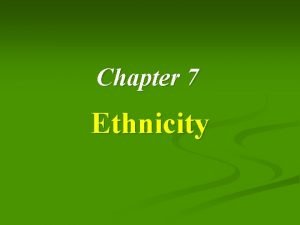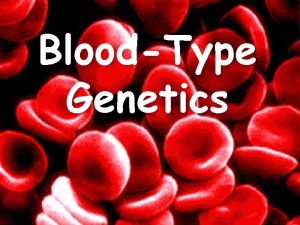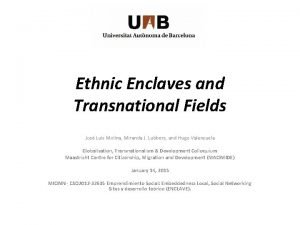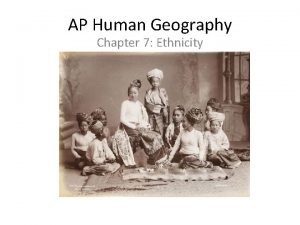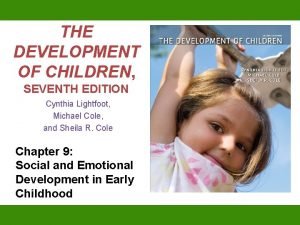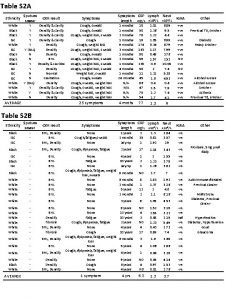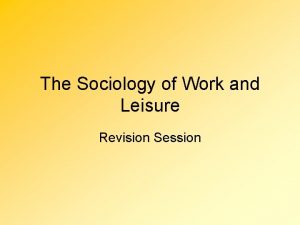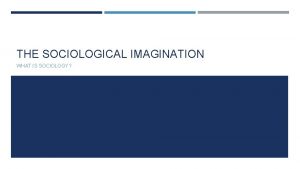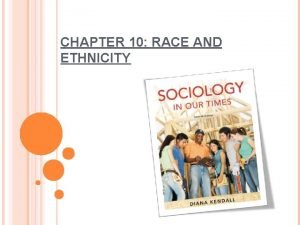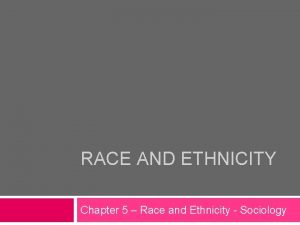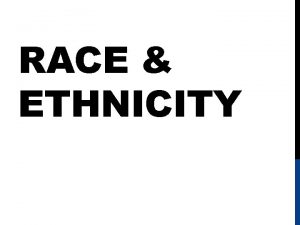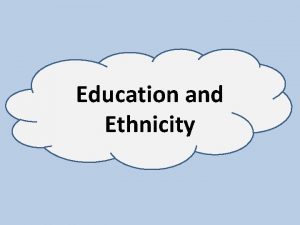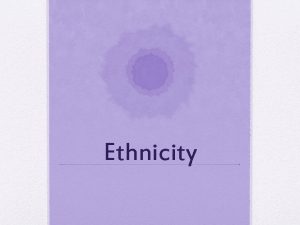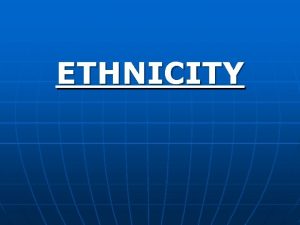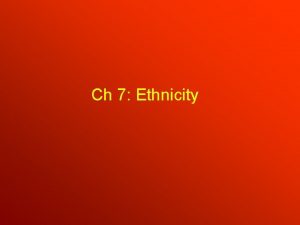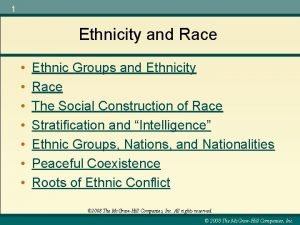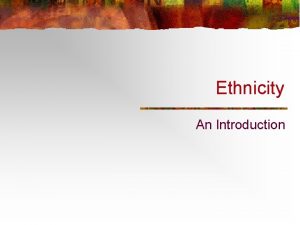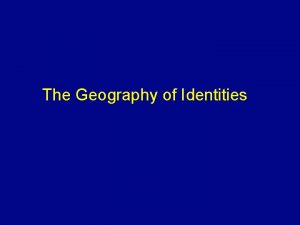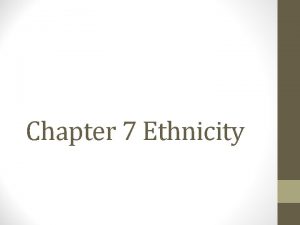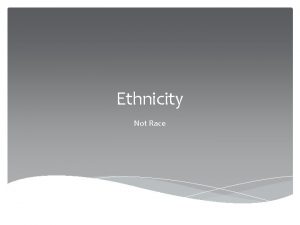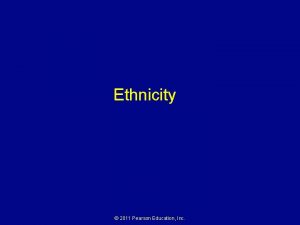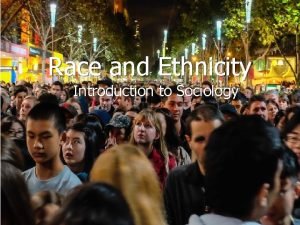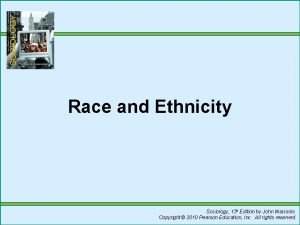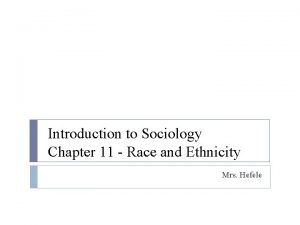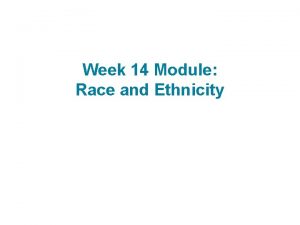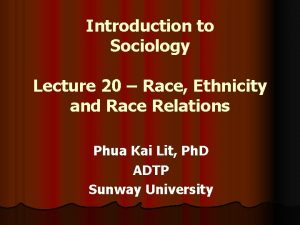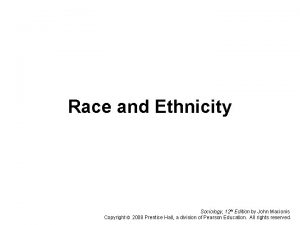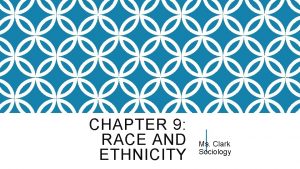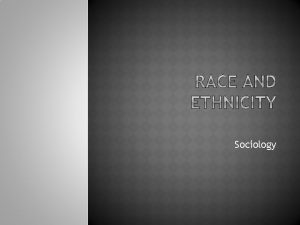RACE AND ETHNICITY SOCIOLOGY 101 1 Race and


































- Slides: 34

RACE AND ETHNICITY SOCIOLOGY 101 1

Race and Ethnicity Sociologists distinguish among racial, ethnic, and minority groups n The term racial group is used to describe a group that is set apart from others because of obvious physical differences. There are no “pure races” Social Construction of Race Social construction is the process by which people come to define a group as a race based on physical, historical, cultural and economic factors. n 2

Ethnicity n Ethnic group: group set apart from others primarily because of its national origin or distinctive cultural patterns n n Distinction between racial and ethnic minorities not always clear-cut Distinction between racial and ethnic groups is socially significant 3

Minority Groups 4. A minority in the sociological sense is a subordinate group whose members have significantly less control or power over their own lives. experience unequal treatment have physical or cultural characteristics different from the dominant group membership is not voluntary (ascribed) strong sense of group solidarity 5. generally marry from within the same group n 1. 2. 3. 4

Prejudice and Discrimination Prejudice - Prejudice is a negative attitude toward an entire category of people Discriminatory Behavior n Denial of opportunities and equal rights to individuals and groups based on some type of arbitrary bias. n Prejudice can result from ethnocentrism n Minorities harbor prejudices too. n A common form of prejudice stereotype. n Self-fulfilling prophecy – when you respond to stereotypes and act on them. 5

The Privileges of the Dominant n Are there any advantages of being White? 1. Housing 2. No suspicion when using credit cards or shopping 3. Parenting 4. Role models in books and media 5. No regard to image reflecting on everyone else 6

Minority, Racial, and Ethnic Groups Table 11 -1. Racial and Ethnic Groups in the United States, 2000 7

Minority, Racial, and Ethnic Groups Figure 11 -1. Racial and Ethnic Groups in the United States, 1500— 2100 (projected) Sources: Author’s estimate; Bureau of the Census 1975; Grieco and Cassidy 2001; Therrien 1987 8

Studying Race and Ethnicity n Functionalist Perspective – Nash’s 3 functions that racially prejudiced beliefs have for the dominant group include: • Moral Justification for maintaining an unequal society • Discouraging subordinate groups from questioning their status • Encouraging support for the existing order 9

Studying Race and Ethnicity n Functionalist Perspective n Rose identified dysfunctions associated with racism • Society that practices • Society must invest time discrimination fails to and money to defend use resources of all barriers to full individuals participation • Discrimination • Racial prejudice aggravates social undercuts goodwill and problems diplomatic relations between nations 10

Studying Race and Ethnicity The Conflict Response – Exploitation Theory: racism keeps minorities in low-paying jobs and supplies the dominant group with cheap labor • The Interactionist Approach – Contact Hypothesis: interracial contact between people of equal status in cooperative circumstances will cause them to become less prejudiced and to abandon old stereotypes n 11

The Psychology of Prejudice Self-Justification involves denigrating a person or n n group to justify maltreatment of them. In this case, self-justification leads to prejudice and discrimination against members of another group We require reassurance that the things we do and the lives we live are proper 12

n n n If we can convince ourselves that another group is inferior, immoral, or dangerous, we may feel justified in discriminating against its members This may involve justification for enslaving and even killing another person. Self-Justification is used when the dominant group’s assumption of an attitude of superiority over other groups 13

Personality Theories Psychologist Theodore Adorno reported a correlation between individuals’ early childhood experiences of harsh parental discipline and their development of an authoritarian personality. n Highly prejudiced individuals tend to come from families that emphasize obedience n People with an authoritarian personality tend to be insecure, and highly conformist. They have a deep respect for authority 14

n n n They rigidly conform to conventional cultural values, envisioning moral issues as clear cut matters or right and wrong Their thinking is oversimplified – others will do the thinking for them. Intolerant of any divergence from what they consider normal in terms of religion, race, history, nationality, culture and language 15

n When children become adults, they may demonstrate displaced aggression - directing their hostility against a powerless group to compensate for their feelings of insecurity and fear 16

Frustration Studies have shown that frustrations tend to increase aggression toward others n Frustrated people don’t strike at the cause of their frustration because is often too nebulous to be identified or too powerful to act against n In such instances, the result may be displaced aggression 17

n n in this situation, the frustrated individual or group will usually redirects anger against a more visible, vulnerable, and socially sanctioned target, one unable to strike back Blaming others for something that is not their fault is known as scapegoating. 18

Sociology of Prejudice Socialization n In the socialization process, individuals acquires the values, attitudes, beliefs n n Generally, the child conforms to the parents’ expectations in acquiring an understanding of the world and its people Being impressionable and knowing of no alternative conceptions of the world, the child usually accepts these concepts without questioning 19

Social Norms Stereotyping n One common reaction to strangers is to categorize them broadly n A stereotype is an oversimplified generalization by which we attribute certain traits or characteristics to a group without regard to individual differences. n Stereotypes distort socio-cultural truths but are socially approved images held by one group about another 20

Institutional Discrimination- the denial of opportunities and equal rights to individual and groups 1. Housing Racial Steering – practice in which real estate brokers refuse to show house outside of specific areas to minority buyers 2. Education 21

Patterns of Intergroup Relations Amalgamation – when a majority group and a minority group combine to form a new group Assimilation Process by which person forsakes his or her own cultural tradition to become part of a different culture Segregation n Refers to physical separation of two groups of people in terms of residence n Apartheid: Republic of South Africa severely restricted the movement of Blacks and non-Whites 22

n Pluralism n Based on mutual respect among various groups in a society for one another’s cultures 23

Race and Ethnicity in the United States • Racial Groups – African Americans n n African Americans currently largest minority group in U. S. Contemporary institutional discrimination and individual prejudice against African Americans rooted in history of slavery n Black Power: rejected goal of assimilation into White middle-class society 24

Race and Ethnicity in the United States • Racial Groups – Native Americans n n n 2. 5 million Native Americans represent diverse array of cultures distinguishable by language, family organization, religion, and livelihood Life remains difficult for members of 554 tribal groups in U. S. Increasing number claiming identity as Native American 25

Race and Ethnicity in the United States • Racial Groups – Asian Americans n n Asian Americans comprise one of fastest growing segments of U. S. population Asian Americans often held up as model or ideal minority group 26

Race and Ethnicity in the United States • Racial Groups – Asian Americans n Vietnamese Americans n n Came to U. S. during and after Vietnam War and, over time, gravitated toward larger urban areas Chinese Americans n n Encouraged to immigrate to U. S. from 1850 to 1880 Currently, about 2. 7 million Chinese Americans live in U. S. 27

Race and Ethnicity in the United States • Racial Groups – Asian Americans • Japanese Americans n n • Issei: first generation of Japanese immigrants In August 1943, 113, 000 Japanese Americans forced into hastily built camps in response to World War II Korean Americans n At 1. 2 million, population of Korean Americans exceeds that of Japanese Americans 28

Race and Ethnicity in the United States Figure 11 -7. Major Asian American Groups in the United States, 2000 Source: Logan 2001 29

Race and Ethnicity in the United States • Racial Groups – Arab Americans n n Up to 3 million people of Arab ancestry reside in the United States Cannot be characterize as having a specific family type, gender role, or occupational pattern Profiling of potential terrorists has put Arab and Muslim Americans under special surveillance 30

Race and Ethnicity in the United States Figure 11 -8. Distribution of the Arab Population by State, 2000 Source: Bureau of the Census 2003 c 31

Race and Ethnicity in the United States • Ethnic Groups – Latinos n n Largest minority in the United States Mexican Americans n n Puerto Ricans n n Largest Latino population Residents of Puerto Rico are American citizens Cuban Americans n Immigration began in earnest following Castro’s assumption of power in Cuban Revolution (1959) 32

Race and Ethnicity in the United States Figure 11 -9. Major Hispanic Groups in the United States, 2002 Source: R. Ramirez and de la Cruz 2003: 1 33

Race and Ethnicity in the United States • Ethnic Groups – Jewish Americans n Constitute almost 3% of population n – Anti-Semitism: anti-Jewish prejudice White Ethnics • White ethnics’ ancestors came from Europe in last 100 years Symbolic ethnicity: emphasis on ethnic food or political issues rather than on deeper ties to one’s ethnic heritage 34
 Chapter 8: race and ethnicity as lived experience
Chapter 8: race and ethnicity as lived experience What is cultural assimilation
What is cultural assimilation Race vs ethnicity vs nationality
Race vs ethnicity vs nationality Hydraulic efficiency formula
Hydraulic efficiency formula Design of dams
Design of dams Data race vs race condition
Data race vs race condition Stateless-nation
Stateless-nation Concept of conflict
Concept of conflict Troian bellisario ethnicity
Troian bellisario ethnicity What is ethnicity
What is ethnicity Sociological functionalism
Sociological functionalism Symbolic ethnicity
Symbolic ethnicity Ethnicity in sociolinguistics
Ethnicity in sociolinguistics Lactose intolerance by country
Lactose intolerance by country Nationality ap human geography definition
Nationality ap human geography definition Ethnicity examples
Ethnicity examples Ethnicity definiton
Ethnicity definiton Ethnicity in postcolonial literature
Ethnicity in postcolonial literature Multinational state
Multinational state Pitaras russian
Pitaras russian Bad blood intertextuality
Bad blood intertextuality Porter novelli healthstyles survey
Porter novelli healthstyles survey Blood type genetics
Blood type genetics Bitwit ethnicity
Bitwit ethnicity Is hispanic an ethnicity
Is hispanic an ethnicity Servingness
Servingness Louis molina ethnicity
Louis molina ethnicity Tower hamlets ethnicity
Tower hamlets ethnicity Shatterbelt definition ap human geography
Shatterbelt definition ap human geography Vivian cash
Vivian cash Bridge nose
Bridge nose Gordon lightfoot ethnicity
Gordon lightfoot ethnicity Isc ethnicity
Isc ethnicity Difference between work and leisure in sociology
Difference between work and leisure in sociology Sociology vs common sense
Sociology vs common sense
